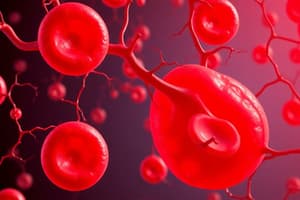Podcast
Questions and Answers
What is a potential complication of marked thrombocytosis?
What is a potential complication of marked thrombocytosis?
- Thrombosis or hemorrhagic episodes (correct)
- Gastric ulcer
- Respiratory failure
- Hypotension
Which mutations are tested for in the diagnosis of Primary Myelofibrosis (PMF)?
Which mutations are tested for in the diagnosis of Primary Myelofibrosis (PMF)?
- EGFR and ALK
- TP53 and KRAS
- BCR-ABL
- JAK2, CALR, and MPL (correct)
How is Primary Myelofibrosis classified according to the 2022 ICC criteria?
How is Primary Myelofibrosis classified according to the 2022 ICC criteria?
- Mild and severe forms
- Early and late stages
- Clinical and biochemical types
- Prefibrotic and overtly fibrotic stages (correct)
Which of the following is NOT a common symptom associated with Primary Myelofibrosis?
Which of the following is NOT a common symptom associated with Primary Myelofibrosis?
What is included in the assessment for the diagnosis of Primary Myelofibrosis?
What is included in the assessment for the diagnosis of Primary Myelofibrosis?
What is the primary characteristic of primary myelofibrosis (PMF)?
What is the primary characteristic of primary myelofibrosis (PMF)?
Which of the following mutations is most commonly associated with primary myelofibrosis?
Which of the following mutations is most commonly associated with primary myelofibrosis?
Which of the following factors contributes to fibroblast formation in PMF?
Which of the following factors contributes to fibroblast formation in PMF?
At what age group is primary myelofibrosis most commonly diagnosed?
At what age group is primary myelofibrosis most commonly diagnosed?
Which clinical feature is the most common presenting symptom of primary myelofibrosis?
Which clinical feature is the most common presenting symptom of primary myelofibrosis?
Which of the following best describes triple-negative primary myelofibrosis?
Which of the following best describes triple-negative primary myelofibrosis?
What is the risk associated with primary myelofibrosis?
What is the risk associated with primary myelofibrosis?
What is the role of the signaling pathway involving JAK2/STAT5 in primary myelofibrosis?
What is the role of the signaling pathway involving JAK2/STAT5 in primary myelofibrosis?
What morphological feature is characteristic of reticulocytosis and polychromatophilia?
What morphological feature is characteristic of reticulocytosis and polychromatophilia?
In the prefibrotic stage of bone marrow examination, what is typically observed?
In the prefibrotic stage of bone marrow examination, what is typically observed?
Which laboratory investigation shows increased levels during the overt fibrotic stage?
Which laboratory investigation shows increased levels during the overt fibrotic stage?
What is the typical cellular composition observed in a bone marrow aspirate during the overt fibrotic stage?
What is the typical cellular composition observed in a bone marrow aspirate during the overt fibrotic stage?
What stain is primarily used to identify stromal structural fibers in bone marrow biopsy specimens?
What stain is primarily used to identify stromal structural fibers in bone marrow biopsy specimens?
What grade of reticulin staining in bone marrow indicates extensive interconnected type I collagen fibers?
What grade of reticulin staining in bone marrow indicates extensive interconnected type I collagen fibers?
Which cellular change is expected in the prefibrotic stage concerning megakaryocytes?
Which cellular change is expected in the prefibrotic stage concerning megakaryocytes?
What should be done to confirm a diagnosis in bone marrow assessment?
What should be done to confirm a diagnosis in bone marrow assessment?
What distinguishes primary myelofibrosis in the overtly fibrotic stage from the pre-fibrotic/early stage regarding reticulin/collagen fibrosis?
What distinguishes primary myelofibrosis in the overtly fibrotic stage from the pre-fibrotic/early stage regarding reticulin/collagen fibrosis?
Which of the following criteria must be met for diagnosing pre-fibrotic stage primary myelofibrosis in terms of megakaryocyte characteristics?
Which of the following criteria must be met for diagnosing pre-fibrotic stage primary myelofibrosis in terms of megakaryocyte characteristics?
Which minor criterion is common to both pre-fibrotic and overtly fibrotic stages of primary myelofibrosis?
Which minor criterion is common to both pre-fibrotic and overtly fibrotic stages of primary myelofibrosis?
In overtly fibrotic stage primary myelofibrosis, what is the expected blood count finding concerning red blood cells?
In overtly fibrotic stage primary myelofibrosis, what is the expected blood count finding concerning red blood cells?
How does leukocytosis present in the pre-fibrotic stage compared to the overtly fibrotic stage of primary myelofibrosis?
How does leukocytosis present in the pre-fibrotic stage compared to the overtly fibrotic stage of primary myelofibrosis?
What is the defining genetic marker that must be present for diagnosing primary myelofibrosis?
What is the defining genetic marker that must be present for diagnosing primary myelofibrosis?
What is a common blood smear finding in overt primary myelofibrosis that aids in diagnosis?
What is a common blood smear finding in overt primary myelofibrosis that aids in diagnosis?
What phenomenon occurs in approximately 15% of patients with essential thrombocythemia (ET) or polycythemia vera (PV)?
What phenomenon occurs in approximately 15% of patients with essential thrombocythemia (ET) or polycythemia vera (PV)?
What characteristic helps differentiate essential thrombocythemia (ET) from prefibrotic primary myelofibrosis (PMF)?
What characteristic helps differentiate essential thrombocythemia (ET) from prefibrotic primary myelofibrosis (PMF)?
Which of the following indicates the potential presence of myelodysplastic syndrome (MDS) or a myelodysplastic/myeloproliferative neoplasm (MDS/MPN)?
Which of the following indicates the potential presence of myelodysplastic syndrome (MDS) or a myelodysplastic/myeloproliferative neoplasm (MDS/MPN)?
What is the median survival rate from onset for patients with primary myelofibrosis?
What is the median survival rate from onset for patients with primary myelofibrosis?
Which of the following is NOT one of the independent predictors of inferior survival according to the International Prognostic Scoring System (IPSS) for primary myelofibrosis?
Which of the following is NOT one of the independent predictors of inferior survival according to the International Prognostic Scoring System (IPSS) for primary myelofibrosis?
What does the dynamic prognostic model (DIPSS) enhance in comparison to the IPSS for primary myelofibrosis?
What does the dynamic prognostic model (DIPSS) enhance in comparison to the IPSS for primary myelofibrosis?
Which condition is likely if a patient exhibits severe constitutional symptoms, pancytopenia, and mild or no splenomegaly?
Which condition is likely if a patient exhibits severe constitutional symptoms, pancytopenia, and mild or no splenomegaly?
What is the significance of the presence of peripheral blood monocytes ≥0.5 × 10^9/L and monocyte percentage ≥10%?
What is the significance of the presence of peripheral blood monocytes ≥0.5 × 10^9/L and monocyte percentage ≥10%?
Which mutation profiles can be expressed by both essential thrombocythemia (ET) and prefibrotic primary myelofibrosis (PMF)?
Which mutation profiles can be expressed by both essential thrombocythemia (ET) and prefibrotic primary myelofibrosis (PMF)?
Flashcards are hidden until you start studying
Study Notes
Primary Myelofibrosis
- A myeloproliferative neoplasm (MPN) characterized by stem cell-derived clonal myeloproliferation
- Often accompanied by JAK2, CALR, or MPL mutations
- Bone marrow reticulin/collagen fibrosis, osteosclerosis, aberrant inflammatory cytokine expression
- Anemia, hepatosplenomegaly, extramedullary hematopoiesis (EMH), constitutional symptoms
- Risk of leukemic progression
- Incidence of 0.44-1.5 / 100,000 person-year
- Predominantly affects individuals aged 60-70 years
Pathophysiology
- Neoplastic transformation of a pluripotent hematopoietic stem cell
- Somatic mutation in the Janus kinase/signal transducer and activator of transcription (JAK2/STAT 5) signaling pathway
- JAK2 mutations in 50-60% of patients
- Increase cytokine responsiveness of myeloid cells
- Mutations in the thrombopoietin receptor gene (MPL) or the calreticulin (CALR) gene
- Triple-negative primary myelofibrosis (no mutations in JAK2, CALR, or MPL)
- Platelets, megakaryocytes, and monocytes secrete cytokines (PDGF, IL-1, TGF beta, BFGF) leading to fibroblast and collagen formation
Clinical Features
- Asymptomatic in 30% of patients
- Symptoms in 70% of patients
- Splenomegaly (90%)
- Hepatomegaly (50%)
- Constitutional symptoms: Fatigue, fever, night sweats, weight loss, anemia
- Leukocytosis or thrombocytosis (common), Leukopenia or thrombocytopenia (less common)
- Gouty arthritis and renal stones
- Thrombosis or hemorrhagic episodes (marked thrombocytosis)
- Pruritus, pulmonary hypertension (uncommon symptoms)
- Symptomatic portal hypertension, variceal bleeding, ascites, non-hepatosplenic EMH, cord compression, pleural effusion, pulmonary hypertension, diffuse extremity pain (complications)
Diagnosis
- 2022 International Consensus Classification (ICC) criteria
- Complete blood count (CBC) and peripheral blood smear
- Bone marrow aspirate and biopsy
- Testing for JAK2, CALR, and MPL mutations
Classification of PMF
- One of four JAK2 mutation-prevalent MPNs (polycythemia vera (PV), essential thrombocythemia (ET), and MPN unclassifiable (MPN-U))
- Included in the 2022 ICC category of myeloid neoplasms (AML, MDS)
- Subcategorized into “prefibrotic” and “overtly fibrotic” stages
International Consensus Classification (ICC) Criteria for Primary Myelofibrosis
- Overtly fibrotic stage - Requires meeting all 3 major criteria and one minor criterion
- Major criteria:
- Megakaryocyte proliferation and atypia, accompanied by ≥grade 2 reticulin/collagen fibrosis
- Presence of JAK2, CALR or MPL mutations, or presence of other clonal markers, or absence of evidence for reactive bone marrow fibrosis
- Not meeting ICC criteria for other myeloid neoplasms
- Minor criteria:
- Anemia not otherwise explained
- Leukocytosis ≥11 × 10 /L
- Palpable splenomegaly
- Increased serum lactate dehydrogenase
- A leukoerythroblastic blood smear
- Major criteria:
- Pre-fibrotic/early stage - Requires meeting all 3 major criteria and one minor criterion
- Major criteria:
- Megakaryocyte proliferation and atypia, accompanied by ≤grade 1 reticulin/collagen fibrosis, granulocyte proliferation/decreased erythropoiesis
- Presence of JAK2, CALR or MPL mutations, or presence of other clonal markers, or absence of evidence for reactive bone marrow fibrosis
- Not meeting ICC criteria for other myeloid neoplasms
- Minor criteria:
- Anemia not otherwise explained
- Leukocytosis ≥11 × 10 /L
- Palpable splenomegaly
- Increased serum lactate dehydrogenase
- Major criteria:
Post-ET or Post-PV Myelofibrosis (MF)
- Approximately 15% of patients with ET or PV develop a PMF-like phenotype
- Similar treatment and outcome to PMF
Complete Blood Count/Peripheral Blood Smear
- Prefibrotic
- Initially normal or increased blood counts
- Mild neutrophilia with a left shift
- Thrombocytosis (mild / moderate)
- No OR / borderline anemia
- No OR/myeloblasts
- No OR/ leukoerythroblastosis
- Overt
- Thrombocytopenia with bizarre abnormal large platelets, altered granulation
- Fragmented megakaryocytes
- Leukoerythroblastosis and anemia
- Myeloblasts (usually > 5%)
Red Blood Cells (RBCs)
- Prefibrotic and Overt Stages
- Poikilocytosis
- Reticulocytosis and polychromatophilia
- Teardrop-shaped RBCs (dacrocytes)
- Nucleated RBCs and neutrophil precursors in peripheral blood
Additional Investigations
- Lactate dehydrogenase (LDH)
- Prefibrotic: normal or borderline increased lactate dehydrogenase
- Overt: increased lactate dehydrogenase
- Increased alkaline phosphatase, uric acid, leukocyte alkaline phosphatase, and vitamin B12
Bone Marrow Examination
- Prefibrotic
- Hypercellular bone marrow
- Atypical megakaryocytic proliferations (clustered megakaryocytes, aberrant N:C ratios, hyperchromatic, bulbous or irregularly folded nuclei, bare megakaryocytic nuclei)
- Reduced erythropoiesis with excess granulocytes
- Absent or only slight reticulin fibrosis
- Overt fibrotic stage
- Hypocellular bone marrow with alternating cellular and hypocellular regions
- Atypical megakaryocytes in tight clusters or sheets
- Bone marrow aspirate often difficult (dry tap) in 50% of patients
- Marrow osteosclerosis with irregular, broad bony trabeculae
- Markedly dilated sinuses
- Bone marrow biopsy essential for confirming the diagnosis
Reticulin and Trichrome Stains
- Reticulin staining (reticulin fibrosis): Increased in benign and malignant conditions
- Trichrome staining (collagen fibrosis): Prominent in late stages of severe myeloproliferative diseases or following tumor metastasis
Bone Marrow Biopsy Grades
- Grade 0: Normal bone marrow with only perivascular type I collagen
- Grade 1: Minimal presence of type I collagen in the center of bone marrow
- Grade 2: Paratrabecular and prominent central deposition with interconnecting collagen fibers
- Grade 3: Extensive interconnected type I collagen fibers
Distinguishing PMF from Other Myeloproliferative Neoplasms
- Patients meeting PV criteria should be labeled as "PV" even with substantial bone marrow fibrosis
- Prefibrotic PMF with thrombocytosis can mimic ET in presentation and mutation profile, requiring careful morphologic examination
- Megakaryocytes in ET are distributed in loose clusters and are large and mature-appearing.
- Megakaryocytes in prefibrotic PMF display tight clusters, abnormal maturation with hyperchromatic and irregularly folded nuclei.
- Prognostically relevant distinction
- MDS or MDS/MPN should be suspected with dyserythropoiesis or dysgranulopoiesis
- CMML should be considered when peripheral blood monocyte count ≥0.5 × 109/L and monocyte percentage ≥10%
- Patients with acute MF (acute panmyelosis with MF or acute megakaryoblastic leukemia) usually present with severe constitutional symptoms, pancytopenia, minimal to no splenomegaly, and increased circulating blasts
Risk Stratification of PMF
- Median survival is 5 years, but variation is wide
- Acute myeloid leukemia development can lead to short survival
- International Prognostic Scoring System (IPSS) (2009) - used at time of diagnosis
- Five independent predictors of inferior survival:
- Age > 65 years
- Hemoglobin < 10 g/dL
- Platelet count < 100 × 109/L
- Circulating blasts ≥1%
- Presence of constitutional symptoms (e.g., fever, night sweats, weight loss)
- Five independent predictors of inferior survival:
- Dynamic International Prognostic Scoring System (DIPSS) - used at any time during the disease course
- Includes IPSS variables and three additional risk factors:
- Platelet count
- Splenomegaly
- Number of constitutional symptoms
- Includes IPSS variables and three additional risk factors:
Studying That Suits You
Use AI to generate personalized quizzes and flashcards to suit your learning preferences.




